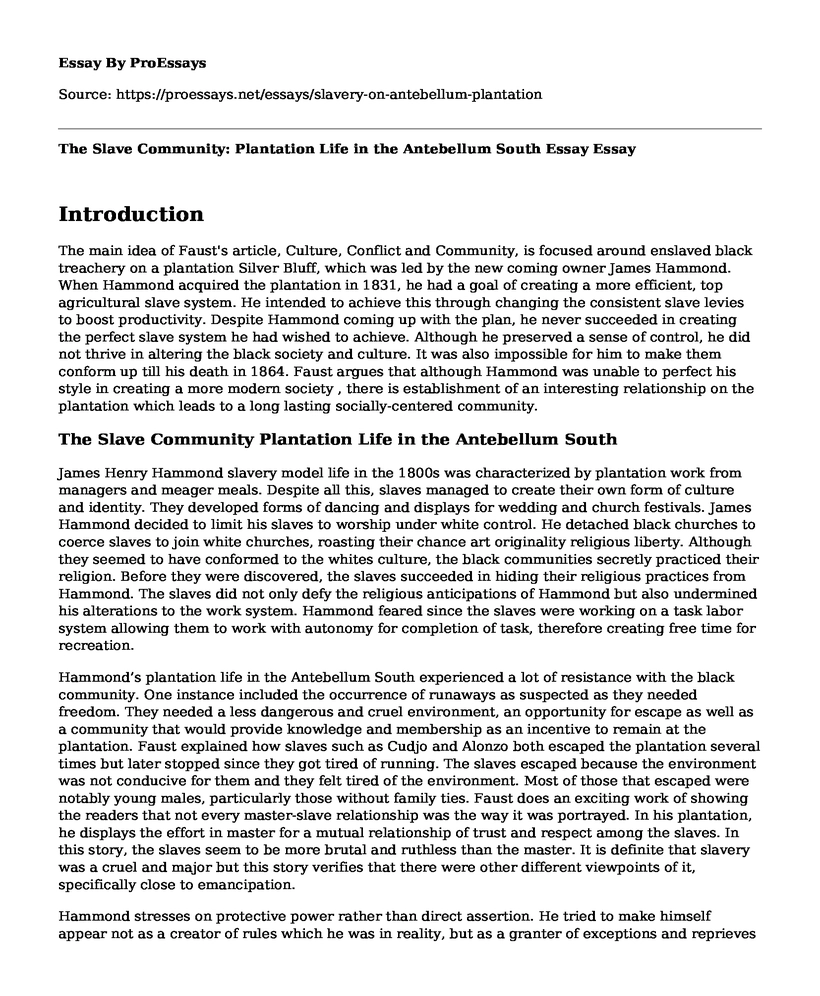Introduction
The main idea of Faust's article, Culture, Conflict and Community, is focused around enslaved black treachery on a plantation Silver Bluff, which was led by the new coming owner James Hammond. When Hammond acquired the plantation in 1831, he had a goal of creating a more efficient, top agricultural slave system. He intended to achieve this through changing the consistent slave levies to boost productivity. Despite Hammond coming up with the plan, he never succeeded in creating the perfect slave system he had wished to achieve. Although he preserved a sense of control, he did not thrive in altering the black society and culture. It was also impossible for him to make them conform up till his death in 1864. Faust argues that although Hammond was unable to perfect his style in creating a more modern society , there is establishment of an interesting relationship on the plantation which leads to a long lasting socially-centered community.
The Slave Community Plantation Life in the Antebellum South
James Henry Hammond slavery model life in the 1800s was characterized by plantation work from managers and meager meals. Despite all this, slaves managed to create their own form of culture and identity. They developed forms of dancing and displays for wedding and church festivals. James Hammond decided to limit his slaves to worship under white control. He detached black churches to coerce slaves to join white churches, roasting their chance art originality religious liberty. Although they seemed to have conformed to the whites culture, the black communities secretly practiced their religion. Before they were discovered, the slaves succeeded in hiding their religious practices from Hammond. The slaves did not only defy the religious anticipations of Hammond but also undermined his alterations to the work system. Hammond feared since the slaves were working on a task labor system allowing them to work with autonomy for completion of task, therefore creating free time for recreation.
Hammond’s plantation life in the Antebellum South experienced a lot of resistance with the black community. One instance included the occurrence of runaways as suspected as they needed freedom. They needed a less dangerous and cruel environment, an opportunity for escape as well as a community that would provide knowledge and membership as an incentive to remain at the plantation. Faust explained how slaves such as Cudjo and Alonzo both escaped the plantation several times but later stopped since they got tired of running. The slaves escaped because the environment was not conducive for them and they felt tired of the environment. Most of those that escaped were notably young males, particularly those without family ties. Faust does an exciting work of showing the readers that not every master-slave relationship was the way it was portrayed. In his plantation, he displays the effort in master for a mutual relationship of trust and respect among the slaves. In this story, the slaves seem to be more brutal and ruthless than the master. It is definite that slavery was a cruel and major but this story verifies that there were other different viewpoints of it, specifically close to emancipation.
Hammond stresses on protective power rather than direct assertion. He tried to make himself appear not as a creator of rules which he was in reality, but as a granter of exceptions and reprieves (Faust, 88). To curb acts of rebellion, Hammond tried to bribe motivation out of them or to inflict punishment. For instance, he would incorporate contests with rewards like Christmas holidays and imposing blows for those who were trying to run away. The reading serves as a proof that the slaves did not suffer without rebellion.
Conclusion
In conclusion, Hammond tried to be a reasonable master to the slaves but all that was in vain. They had already made up their mind that Antebellum plantation slavery life was not what they wanted. He tried using protective power with the slaves but in reality no one wants to be enslaved. Free will and freedom is what everyone desires. Creation is culture and identity is what makes us unique and gives us something to identify with. This is what the black slaves initiated culture and identity. Religion was one issue that all the slaves needed. Freedom of worship should be exercised but with Hammond, it was not the case. Therefore, religion, culture and identity were what the slaves wanted.
Reference
Drew Gilpin Faust, "Culture, Conflict, and Community: The Meaning of Power on an Antebellum Plantation/' Jounud of Social History, vol. 14~ no. 1 (Fall 1980): 83-97. Reprinted by permission of JoUI'IUJl of Social History.
Cite this page
The Slave Community: Plantation Life in the Antebellum South Essay. (2021, Mar 04). Retrieved from https://proessays.net/essays/slavery-on-antebellum-plantation
If you are the original author of this essay and no longer wish to have it published on the ProEssays website, please click below to request its removal:
- David Koresh Biography
- Essay Example on Ancient Egypt & Mesopotamia: Male-Dominated Societies
- Language: A Powerful Tool to Express & Relate - Essay Sample
- Essay Example on Nurturing Young Minds: Unlocking Brilliance in Kids Ages 2-8
- Essay Example on WW1: Empires Fall, Nations Rise, US Joins Global Conflict
- Essay Sample on The Rise and Growth of Slavery: Its Impact on Africa
- Essay Example on Spencer: A Victorian-Age Advocate for Science & Individualism







